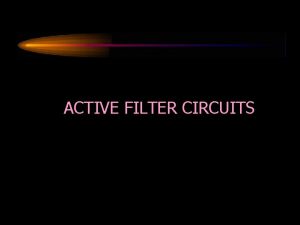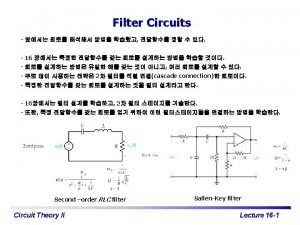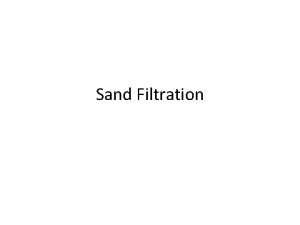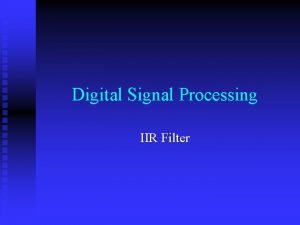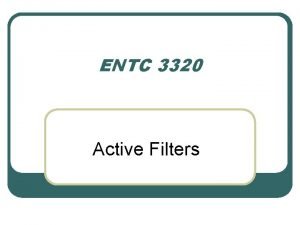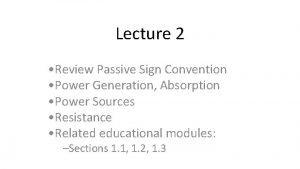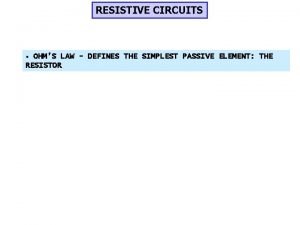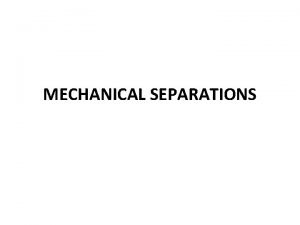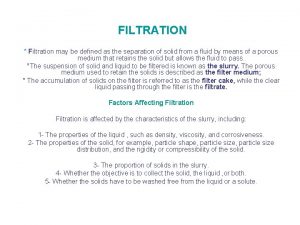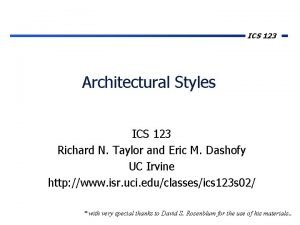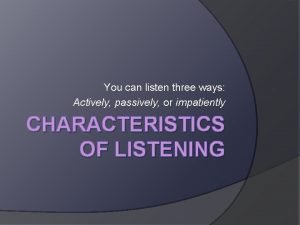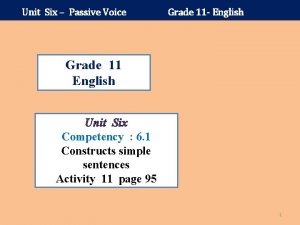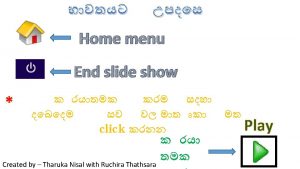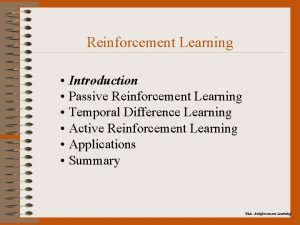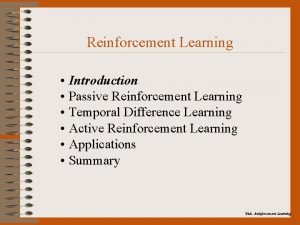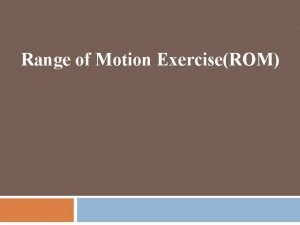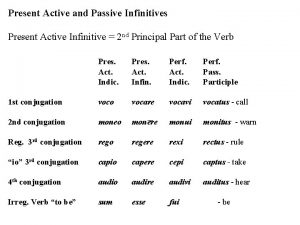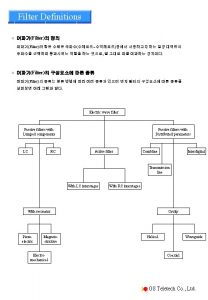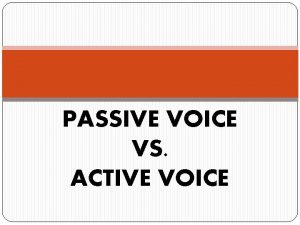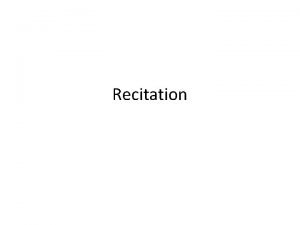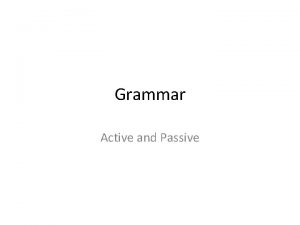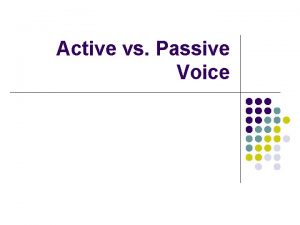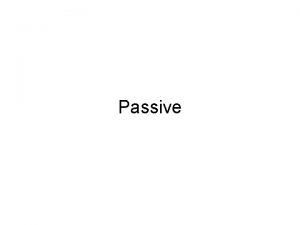ACTIVE FILTER CIRCUITS DISADVANTAGES OF PASSIVE FILTER CIRCUITS









































- Slides: 41

ACTIVE FILTER CIRCUITS

DISADVANTAGES OF PASSIVE FILTER CIRCUITS n n n Passive filter circuits consisting of resistors, inductors, and capacitors are incapable of amplification, because the output magnitude does not exceed the input magnitude. The cutoff frequency and the passband magnitude of passive filters are altered with the addition of a resistive load at the output of the filter. In this section, filters using op amps will be examined. These op amp circuits overcome the disadvantages of passive filter circuits. Circuit Analysis II Spring 2005 Osman Parlaktuna

FIRST-ORDER LOW-PASS FILTER C R 1 R 2 + vi Zf + Circuit Analysis II Zi + vo vi + Spring 2005 + + vo Osman Parlaktuna

PROTOTYPE LOW-PASS FIRSTORDER OP AMP FILTER Design a low-pass first-order filter with R 1=1Ω, having a passband gain of 1 and a cutoff frequency of 1 rad/s. Circuit Analysis II Spring 2005 Osman Parlaktuna

FIRST-ORDER HIGH-PASS FILTER C R 2 R 1 + vi + vo + Prototype high-pass filter with R 1=R 2=1Ω and C=1 F. The cutoff frequency is 1 rad/s. The magnitude at the passband is 1. Circuit Analysis II Spring 2005 Osman Parlaktuna

EXAMPLE Figure shows the Bode magnitude plot of a high-pass filter. Using the active high-pass filter circuit, determine values of R 1 and R 2. Use a 0. 1μF capacitor. If a 10 KΩ load resistor is added to the filter, how will the magnitude response change? Circuit Analysis II Spring 2005 Osman Parlaktuna

Notice that the gain in the passband is 20 d. B, therefore, K=10. Also note the 3 d. B point is 500 Hz. Then, the transfer function for the high-pass filter is Because the op amp in the circuit is ideal, the addition of any load resistor has no effect on the behavior of the op amp. Thus, the magnitude response of the high-pass filter will remain the same when a load resistor is connected. Circuit Analysis II Spring 2005 Osman Parlaktuna

SCALING In the design of both passive and active filters, working with element values such as 1 Ω, 1 H, and 1 F is convenient. After making computations using convenient values of R, L, and C, the designer can transform the circuit to a realistic one using the process known as scaling. There are two types of scaling: magnitude and frequency. A circuit is scaled in magnitude by multiplying the impedance at a given frequency by the scale factor km. Thus, the scaled values of resistor, inductor, and capacitor become where the primed values are the scaled ones. Circuit Analysis II Spring 2005 Osman Parlaktuna

In frequency scaling, we change the circuit parameter so that at the new frequency, the impedance of each element is the same as it was at the original frequency. Let kf denote the frequency scale factor, then A circuit can be scaled simultaneously in both magnitude and frequency. The scaled values in terms of the original values are Circuit Analysis II Spring 2005 Osman Parlaktuna

EXAMPLE 1 H vi + This circuit has a center frequency of 1 rad/s, a 1 F bandwidth of 1 rad/s, and a quality factor of 1. Use + scaling to compute the values of R and L that yield 1Ω vo a circuit with the same quality factor but with a center frequency of 500 Hz. Use a 2 μF capacitor. The frequency scaling factor is: The magnitude scaling factor is: Circuit Analysis II Spring 2005 Osman Parlaktuna

EXAMPLE Use the prototype low-pass op amp filter and scaling to compute the resistor values for a low-pass filter with a gain of 5, a cutoff frequency of 1000 Hz, and a feedback capacitor of 0. 01 μF. To meet the gain specification, we can adjust one of the resistor values. But, changing the value of R 2 will change the cutoff frequency. Therefore, we can adjust the value of R 1 as R 1=R 2/5=3183. 1 Ω. Circuit Analysis II Spring 2005 Osman Parlaktuna

OP AMP BANDPASS FILTERS A bandpass filter consists of three separate components 1. A unity-gain low-pass filter whose cutoff frequency is wc 2, the larger of the two cutoff frequencies 2. A unity-gain high-pass filter whose cutoff frequency is wc 1, the smaller of the two cutoff frequencies 3. A gain component to provide the desired level of gain in the passband. 4. These three components are cascaded in series. The resulting filter is called a broadbandpass filter, because the band of frequencies passed is wide. Circuit Analysis II Spring 2005 Osman Parlaktuna

Vi Low-pass filter High-pass filter Vo Inverting amplifier CL RH RL RL + vi + Circuit Analysis II CH RH Rf Ri + Spring 2005 + + vo Osman Parlaktuna

Standard form for the transfer function of a bandpass filter is In order to convert H(s) into the standard form, it is required that. If this condition holds, Then the transfer function for the bandpass filter becomes Circuit Analysis II Spring 2005 Osman Parlaktuna

Compute the values of RL and CL to give us the desired cutoff frequency Compute the values of RH and CH to give us the desired cutoff frequency To compute the values of Ri and Rf, consider the magnitude of the transfer function at the center frequency wo Circuit Analysis II Spring 2005 Osman Parlaktuna

EXAMPLE Design a bandpass filter to provide an amplification of 2 within the band of frequencies between 100 and 10000 Hz. Use 0. 2 μF capacitors. Arbitrarily select Ri=1 kΩ, then Rf=2 Ri=2 KΩ Circuit Analysis II Spring 2005 Osman Parlaktuna

OP AMP BANDREJECT FILTERS Like the bandpass filters, the bandreject filter consists of three separate components • The unity-gain low-pass filter has a cutoff frequency of wc 1, which is the smaller of the two cutoff frequencies. • The unity-gain high-pass filter has a cutoff frequency of wc 2, which is the larger of the two cutoff frequencies. • The gain component provides the desired level of gain in the passbands. The most important difference is that these components are connected in parallel and using a summing amplifier. Circuit Analysis II Spring 2005 Osman Parlaktuna

CL RL RL Ri Rf + vi Ri + + + vo RH CH RH + Circuit Analysis II Spring 2005 Osman Parlaktuna

The magnitude of the transfer function at the center frequency Circuit Analysis II Spring 2005 Osman Parlaktuna

HIGHER ORDER OP AMP FILTERS All of the filters considered so far are nonideal and have a slow transition between the stopband passband. To obtain a sharper transition, we may connect identical filters in cascade. For example connecting two first-order low-pass identical filters in cascade will result in -40 d. B/decade slope in the transition region. Three filters will give -60 d. B/decade slope, and four filters should have -80 db/decade slope. For a cascaded of n protoptype low-pass filters, the transfer function is Circuit Analysis II Spring 2005 Osman Parlaktuna

Circuit Analysis II Spring 2005 Osman Parlaktuna

But, there is a problem with this approach. As the order of the low-pass is increased, the cutoff frequency changes. As long as we are able to calculate the cutoff frequency of the higher-order filters, we can use frequency scaling to calculate the component values that move the cutoff frequency to its specified location. For an nth-order low-pass filter with n prototype low-pass filters Circuit Analysis II Spring 2005 Osman Parlaktuna

EXAMPLE Design a fourth-order low-pass filter with a cutoff frequency of 500 rad/s and a passband gain of 10. Use 1 μF capacitors. Thus, R=138. 46Ω and C=1 μF. To set the passband gain to 10, choose Rf/Ri=10. For example Rf=1384. 6 Ω and Ri =138. 46 Ω. Circuit Analysis II Spring 2005 Osman Parlaktuna

1μF 138. 46Ω + vi 1μF 138. 46Ω + + + 1μF 1384. 6Ω 138. 46Ω + + vo Circuit Analysis II Spring 2005 Osman Parlaktuna

By cascading identical prototype filters, we can increase the asymptotic slope in the transition and control the location of the cutoff frequency. But the gain of the filter is not constant between zero and the cutoff frequency. Now, consider the magnitude of the transfer function for a unity-gain low-pass nth order cascade. Circuit Analysis II Spring 2005 Osman Parlaktuna

BUTTERWORTH FILTERS A unity-gain Butterworth low-pass filter has a transfer function whose magnitude is given by 1. The cutoff frequency is wc for all values of n. 2. If n is large enough, the denominator is always close to unity when w<wc. 3. In the expression for |H(jw)|, the exponent of w/wc is always even. Circuit Analysis II Spring 2005 Osman Parlaktuna

Given an equation for the magnitude of the transfer function, how do we find H(s)? To find H(s), note that if N is a complex quantity, the |N|2=NN*. Then, Circuit Analysis II Spring 2005 Osman Parlaktuna

The procedure for finding H(s) for a given n is: 1. Find the roots of the polynomial 1+(-1)ns 2 n=0 2. Assign the left-half plane roots to H(s) and the right-half plane roots to H(-s) 3. Combine terms in the denominator of H(s) to form first- and second-order factors Circuit Analysis II Spring 2005 Osman Parlaktuna

EXAMPLE Find the Butterworth transfer function for n=2. For n=2, 1+(-1)2 s 4=0, then s 4=-1=1 1800 Roots s 2 and s 3 are in the left-half plane. Thus, Circuit Analysis II Spring 2005 Osman Parlaktuna

Normalized Butterworth Polynomials Circuit Analysis II Spring 2005 Osman Parlaktuna

BUTTERWORTH FILTER CIRCUITS To construct a Butterworth filter circuit, we cascade first- and second-order op amp circuits using the polynomials given in the table. A fifth-order prototype Butterworth filter is shown in the following figure: vi vo All odd-order Butterworth polynomials include the factor (s+1), so all odd-order BUtterworth filters must include a subcircuit to implement this term. Then we need to find a circuit that provides a transfer function of the form Circuit Analysis II Spring 2005 Osman Parlaktuna

C 1 R vi + R Va + C 2 Circuit Analysis II + Vo Spring 2005 Osman Parlaktuna

EXAMPLE Design a fourth-order low-pass filter with a cutoff frequency of 500 Hz and a passband gain of 10. Use as many 1 KΩ resistor as possible. From table, the fourth-order Butterworth polynomial is For the first stage: C 1=2/0. 765=2. 61 F, C 2=1/2. 61=0. 38 F For the second stage: C 3=2/1. 848=1. 08 F, C 4=1/1. 08=0. 924 F These values along with 1 -Ω resistors will yield a fourth-order Butterworth filter with a cutoff frequency of 1 rad/s. Circuit Analysis II Spring 2005 Osman Parlaktuna

A frequency scale factor of kf=3141. 6 will move the cutoff frequency to 500 Hz. A magnitude scale factor km=1000 will permit the use of 1 kΩ resistors. Then, R=1 kΩ, C 1=831 n. F, C 2=121 n. F, C 3= 344 n. F, C 4=294 n. F, Rf= 10 kΩ. C 3 C 1 R vi + Rf R R Ri R + + C 2 Circuit Analysis II C 4 Spring 2005 + + Vo Osman Parlaktuna

The Order of a Butterworth Filter As the order of the Butterworth filter increases, the magnitude characteristic comes closer to that of an ideal low-pass filter. Therefore, it is important to determine the smallest value of n that will meet the filtering specifications. |H(jw)| Pass band Transition band WP WS Stop band log 10 w AP AS Circuit Analysis II Spring 2005 Osman Parlaktuna

Circuit Analysis II Spring 2005 Osman Parlaktuna

If wp is the cutoff frequency, then For a steep transition region, Circuit Analysis II Thus, Spring 2005 Osman Parlaktuna

EXAMPLE Determine the order of a Butterworth filter that has a cutoff frequency of 1000 Hz and a gain of no more than -50 d. B at 6000 Hz. What is the actual gain in d. B at 6000 Hz? Because the cutoff frequency is given, and 10 -0. 1(-50)>>1 Therefore, we need a fourth-order Butterworth filter. The actual gain at 6000 Hz is Circuit Analysis II Spring 2005 Osman Parlaktuna

EXAMPLE Determine the order of a Butterworth filter whose magnitude is 10 d. B less than the passband magnitude at 500 Hz and at least 60 d. B less than the passband magnitude at 5000 Hz. Thus we need a third-order filter. Determine the cutoff frequency. Circuit Analysis II Spring 2005 Osman Parlaktuna

BUTTERWORTH HIGH-PASS FILTERS To produce the second-order factors in the Butterworth polynomial, we need a circuit with a transfer function of C vi + R 1 C R 2 Circuit Analysis II Setting C= 1 F + + Vo Spring 2005 Osman Parlaktuna

NARROWBANDPASS AND BANDREJECT FILTERS The cascade or parallel component designs from simpler low-pass and high-pass filters will result in low-Q filters. Consider the transfer function Thus with discrete real poles, the highest quality factor bandpass filter we can achieve has Q=1/2 Circuit Analysis II Spring 2005 Osman Parlaktuna
 Disadvantages of low pass filter
Disadvantages of low pass filter Advantages of parallel circuit over series circuit
Advantages of parallel circuit over series circuit Frequency selective circuits
Frequency selective circuits Perbedaan rapid sand filter dan slow sand filter
Perbedaan rapid sand filter dan slow sand filter Iir filter design by approximation of derivatives
Iir filter design by approximation of derivatives Difference between rapid sand filter and slow sand filter
Difference between rapid sand filter and slow sand filter Sinexcel active harmonic filter
Sinexcel active harmonic filter Advantage of active filter
Advantage of active filter Passive convention
Passive convention Passive sign convention circuits
Passive sign convention circuits And or boolean
And or boolean Membrane structures that function in active transport
Membrane structures that function in active transport Primary active transport vs secondary active transport
Primary active transport vs secondary active transport In series vs in parallel
In series vs in parallel Leaf filter advantages and disadvantages
Leaf filter advantages and disadvantages Plate and frame filter advantages and disadvantages
Plate and frame filter advantages and disadvantages Ics123
Ics123 Baghouse filter advantages and disadvantages
Baghouse filter advantages and disadvantages Active and passive listening
Active and passive listening Louise made the chocolate cake active or passive
Louise made the chocolate cake active or passive Label the following sentences active or passive
Label the following sentences active or passive How to turn sentences into passive voice
How to turn sentences into passive voice Louise made the chocolate cake active or passive
Louise made the chocolate cake active or passive Passive vs active transport
Passive vs active transport Active attack and passive attack
Active attack and passive attack Passive infinitive after modal verbs
Passive infinitive after modal verbs Active and passive voice comic strip
Active and passive voice comic strip I had worn blue shoes
I had worn blue shoes Range of motion active and passive
Range of motion active and passive Passive and active reinforcement learning
Passive and active reinforcement learning What is passive reinforcement learning
What is passive reinforcement learning What is active range of motion
What is active range of motion Types of rom exercises
Types of rom exercises Range of motion meaning
Range of motion meaning Range of motion exercise definition
Range of motion exercise definition Supervision active et passive
Supervision active et passive Present perfect simple passive
Present perfect simple passive Active infinitive
Active infinitive Active voice contains which of the following patterns?
Active voice contains which of the following patterns? Active vs passive voice
Active vs passive voice Active and passive range of motion
Active and passive range of motion Passive voice in present perfect continuous
Passive voice in present perfect continuous
